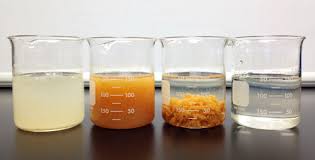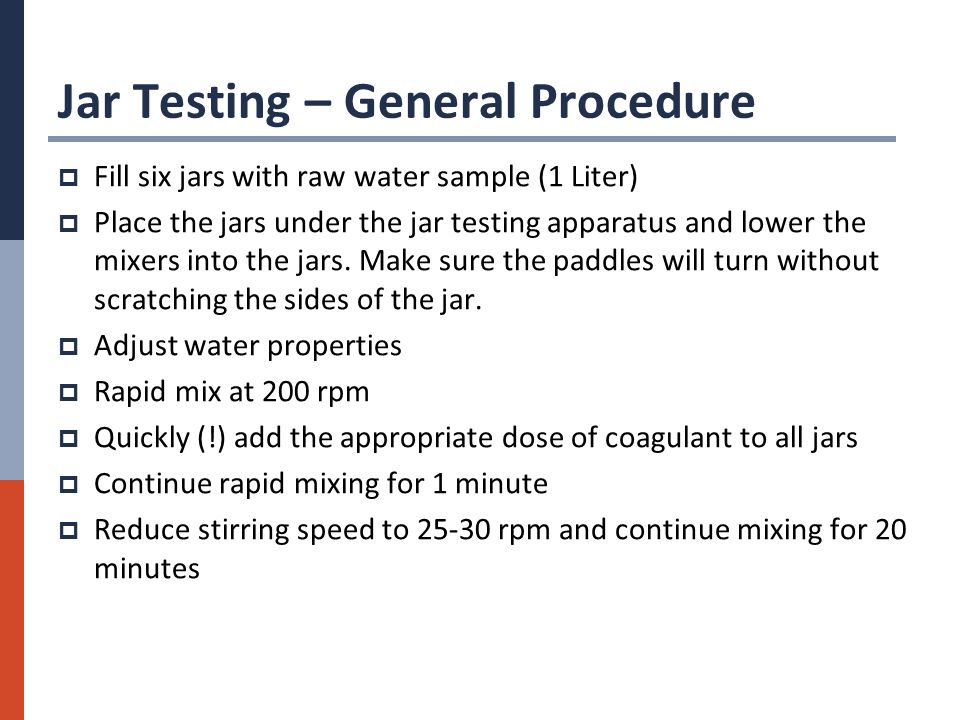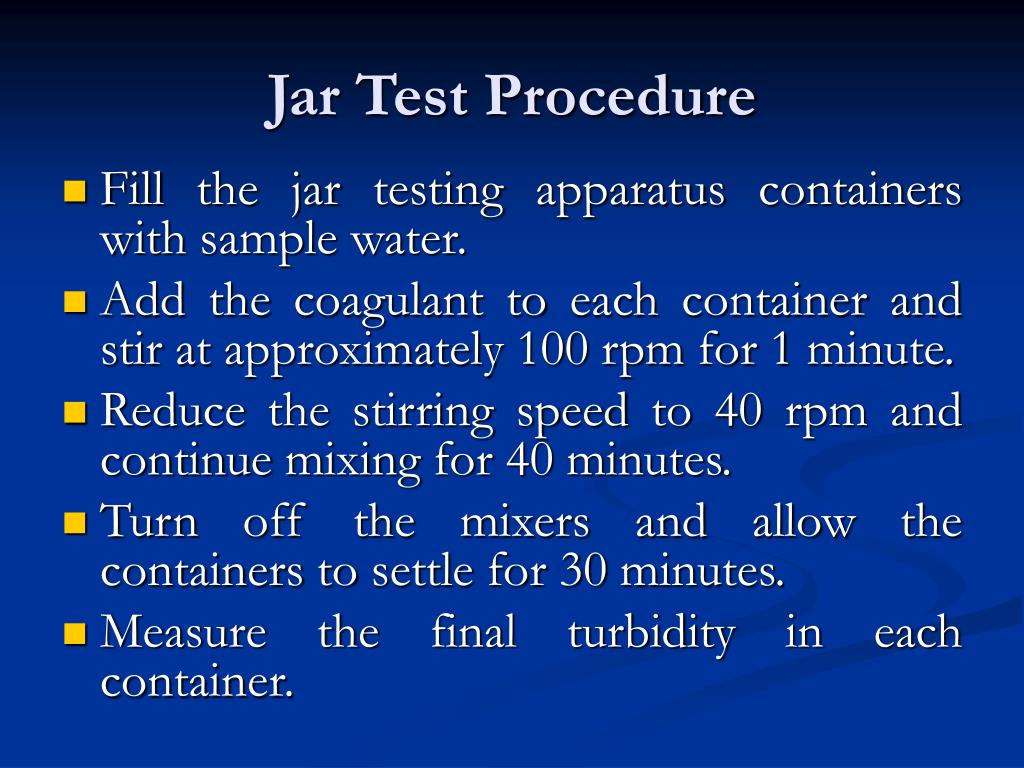jar test procedure
Jar Testing Procedure. Granted a good depend-able six-station jar tester isnt cheap.

The Importance Of Jar Test In Water And Wastewater Analysis
Representative jar testing means that the jar test procedure will imitate the coagulation flocculation and settling conducted in the water plant.

. However other common chemicals can be used such as soda ash and lime. Various amounts of chemicals are added to each jar stirred and the settling of solids is observed. Take 1-litre beakers and fill them with sample up to the mark.
Start the stirrer and carefully place the whole slide coverdisc into the beaker. But they just cant seem to justify the cost of the equipment. Identify which coagulant chemistries you plan to.
The purpose of the jar test is to estimate the minimum coagulant dose required to achieve certain water quality goals. Jar Test - Filterability Test. The price of a complete set-up can be 2000 or more.
Field and laboratory results validated the developed jar test and filterability procedures accurately predicting full-scale plant filtration performance and indirect organic reductions. This video goes over the basics of jar testing for drinking water treatment and provides a demonstration of the next-generation jar test procedure. Soil Texture Analysis The Jar Test Procedure Materials.
For some applications nickel complexes magnesium hydroxide is an effective reagent. Measure exactly 1000 milliliters of raw water into each beaker. With well-mixed test water using a 1000 mL graduate.
A jar test procedure as described above can help to establish the optimum pH within the 75 to 11 range. Although the procedure is not outlined in Standard Methods it is used in most water treatment plants to find the best coagulant dosages under varying conditions. They know they should be jar testing.
Jar tests are conducted on a four- or six-place gang stirrer which can be utilized to. The results of this proce-dure can help optimize the performance of the plant. For adjusting pH sodium hydroxide is recommended.
In many cases that can be a big chunk of a small systems annual equipment budget. Evaluate soil texture use a simple jar test to determine the percentages of sand silt and clay. The paddles can be rotated with varying speed with the help of a motor and regulator.
There is no single jar test procedure will duplicate all of these processes for all plants however experience shows that jar test procedures can be individually tailored to accurately predict. Using a mesh sieve or old colander sift the soil to remove any debris rocks and large organic matter leaves sticks roots etc. These coagulants have become the products of choice in well over 1000 water treatment applications throughout the US sold direct or through distributors.
Individual jar tests were conducted from 2018to 2020 for 37 of the states public surface water treatment plants using var ious treatment technologies. Fill the jar ⅓ full of the soil to be tested. By jar testing on a sample of wastewater generated from your production line significant benefits emerge such as p roduct compatibility and validation c orrect chemical dose and injection rate and projected use-cost.
Wastewater 369 Jar Testing Procedures By Dave Christophersen CWT D eciding On Coagulant Chemistries A. Once the percentages are calculated the soil textural triangle can be used to determine the soil type. Test Procedure Preparing the Samples.
Samples of water to be treated are placed in six jars. Syringe 25 mL from jar after 5 minutes of settling Attached filter holder housing 12 um membrane filter to syringe. Take several readings before recording final NTU results.
Filter-to-waste 3-5 mL drip rate Filter directly into clean cuvette drip rate 15 mL50-90 sec Measure turbidity. 6 paddle gang stirrer. Below we lay out how to jar test coagulants and flocculants in 9 simple steps.
Keep each beaker below each paddle and lower the paddles such that each one is about 1cm above. Jar test is a pilot-scale laboratory test that simulates coagulation or flocculation with differing chemical doses. The jar testing procedure described herein is provided by Turbid Water Solutions to assist our.
Place the filled jars on the gang stirrer with. Apply only enough hydrated lime to raise the pH to between 7. The lowest dose of chemicals that provides satisfactory.
The jar test device consists of a number of stirrers 4 to 6 provided with paddles. Jar test is a pilot-scale laboratory test that simulates coagulation or flocculation with differing chemical dosesThe purpose of this test is to estimate the minimum coagulant dose required to achieve certain water quality goals. The purpose of the procedure is to estimate the minimum coagulant dose required to achieve certain water quality goals.
Straight edged clear jar Permanent marker Ruler Watch or stop watch. Using the microsyringe premeasure each dosage onto the microscope slide cover or rubber disc. USALCO has manufactured chemicals for over 60 years and began full scale production of the patented process.
The jar test a laboratory procedure to determine the optimum pH and the optimum coagulant dose A jar test simulates the coagulation and flocculation processes Fill the jars with raw water sample 500 or 1000 mL usually 6 jars Adjust pH of the jars while mixing. Jar Testing Procedures The following jar test procedure uses alum aluminum sulfate a chemical for coagulation flocculation in water treatment and a typical six-gang jar tester. Jar filled with water leaving space at top.
PH lower than 65 may require buffering with a sprinkle of hydrated lime. Jar Testing Procedure. Want to jar test.
The purpose of the laboratory jar test is to select and quantify a treatment program for removal of. The jar test is a method of measuring the effect of coagulation flocculation and sedimentation on turbidity. 6 one liter beakers.
In other words jar test helps to determine the right amount of treatment chemicals. What is jar test. USALCOs Polyaluminum Chlorides PACL fall under the trade name DelPAC.
The general procedure for jar testing is as follows. N the drinking water field the jar test is described as a. Fill the remainder of the jar with clean water but leave some space at.
Fill the appropriate number of matched 1000 mL square transparent jars. First using a 1000 milliliter mL gradu-ated cylinder add 1000 mL of raw. Measure and record the pH of the raw water samples prior to commencing the jar test.
The jar test has been and is ah important drinking water treatment plant design process control and research tool.

Traditional Jar Test Result Download Table

Traditional Jar Test Result Download Table

Flow Chart Procedure Of Jar Test Experiments 0 5 Ppm 5 0 5 Mg L Download Scientific Diagram

The Importance Of Jar Test In Water And Wastewater Analysis

Learn What Jar Testing Is And How To Do It Furrow Pump

Jar Testing Of Chemical Dosages Ppt Video Online Download

Lesson 5 Coagulation Flocculation

Jar Test Procedure For Both Experimental Set Ups A Procedure Without Download Scientific Diagram

The Importance Of Jar Test In Water And Wastewater Analysis

Flow Chart Procedure Of Jar Test Experiments 0 5 Ppm 5 0 5 Mg L Download Scientific Diagram

Details Of Jar Test Procedure Download Table

Coagulation Flocculation And Jar Testing Ppt Video Online Download
Flowchart Of Jar Test Procedure To Determine The Best Dosage Of Download Scientific Diagram

Wso Jar Testing Dvd Preview Youtube

Ppt Jar Test Powerpoint Presentation Free Download Id 663769

